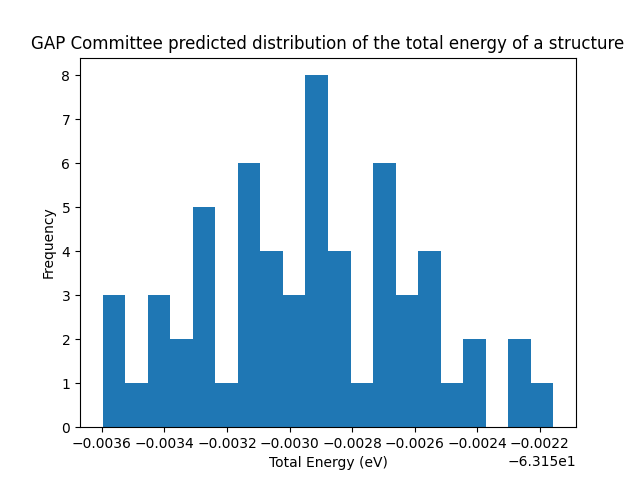Committee Modelling using GAP potentials
Because GAP models are linear with respect to the weights, the full posterior distribution on the coefficients, \(c\), is analytic:
This means that the full posterior can be evaluated and saved during fitting, and that samples from the posterior can be drawn at any time.
Exporting the GAP Posterior Covariance
In order to access the posterior covariance matrix, a new GAP model needs to be trained by gap_fit with the export_covariance=T command line option.
When the model is trained using SCALAPACK, this should create a new file of the form <GAP_NAME>.R.<GAP_LABEL>.
The matrix \(R\) defined by the file is a square root of the posterior precision matrix, IE \(c \sim \mathcal{N}(\mu_c, (R^T R)^{-1})\).
Drawing committees from the Posterior Covariance
The quippy.gap_tools module contains a thin wrapper class to the GAP XML file, which we can use in order to draw a committee of models.
The get_xml_committee function can be used to generate a list of committee members in the form of these wrapper classes.
The committee members can each be saved back down to xml files using the <object>.save(fname) method, or transformed into quippy.potential.Potential calculators using the <object>.as_potential() method.
The get_calc_committee function works similarly to get_xml_committee, except that it returns the Potential objects directly. Potential objects created by get_calc_committee or <xml_wrapper_object>.as_potential() are given an additional attribute potential.xml, which is a reference to the corresponding xml wrapper.
Each xml wrapper object stored all the information required to generate new committee samples, which means that calling <object>.draw_posterior_samples(num_samples) will generate a new list of xml wrapper objects corresponding to a new committee.
Code Example
The code block generates an xml wrapper committee from a GAP xml file. It then saves down the committee, and generates a list of potentials. Finally, it uses the committee to test the uncertainty in a prediction of total energy.
%pylab inline
from ase.io import read
from quippy.gap_tools import get_xml_committee
import numpy as np
import matplotlib.pyplot as plt
gap_xml = "Carbon_GAP.xml"
num_committors = 60
# Generate committee from given GAP model
xml_committee = get_xml_committee(gap_xml, num_committors)
calc_committee = []
# Save all committee members to XML files
# Generate a list of quippy Potentials for committee
for i in range(num_committors):
xml_committee[i].save(f"GAP_Committee/Committor_{i}.xml")
calc_committee.append(xml_committee[i].as_potential())
structure = read("Carbon_Data_Set_Subset.xyz", index="0")
E_pred = np.zeros((num_committors))
# Sample total energy on a structure
for i in range(num_committors):
structure.calc = calc_committee[i]
E_pred[i] = structure.get_potential_energy()
plt.hist(E_pred, bins=20)
plt.xlabel("Total Energy (eV)")
plt.ylabel("Frequency")
plt.title("GAP Committee predicted distribution of the total energy of a structure")
plt.savefig("GAP_Committee_Test.png")
